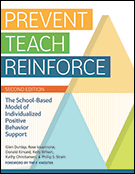5 Steps for Reducing Challenging Behaviors
Educators like you spend a lot of time during a typical school day anticipating the needs of every student—and trying to get ahead of any potential behavior problems. Whether your school district has implemented the Multi-Tiered Systems of Support (MTSS) framework, or you have a less formal support system in place, you know that the social-emotional health of your students is essential to meeting classroom objectives. But sometimes, conventional procedures just aren’t enough to meet the needs of children with persistent challenging behaviors. Some students need specific, targeted supports as they work toward social, emotional, and academic success.

Prevent-Teach-Reinforce
In this article we’ll look at five steps—adapted from the new second edition of Prevent-Teach-Reinforce—for reducing challenging behaviors not adequately addressed by standard behavior management plans. Derived from the principles of Positive Behavioral Interventions & Supports (PBIS), this team-based approach has been proven effective by research and field testing in classrooms like yours and is easily adaptable to the needs and goals of each child.
Learn more in Prevent-Teach-Reinforce.
Step 1: Assemble your team and set goals
Team-based behavior intervention relies on detailed input from people who know the student best, both in school and at home. Your first step is to put together a team—usually consisting of 3 to 7 people—that includes:
- A student’s primary teacher
- Other school employees who spend a lot of time with the student
- A parent or primary caregiver
- A representative from school administration
- A school psychologist or guidance counselor
Each team should choose a facilitator who will be tasked with keeping meetings on track, encouraging participation from all members, and ensuring that a consensus is reached for each agenda item. Glen Dunlap, Ph.D., lead author of Prevent-Teach-Reinforce, emphasizes that a clear, consistent vision is key: “Team members must be united in their commitment to helping the student overcome behavioral challenges and establish a more constructive and healthier pattern of social-emotional development,” he says. “Adopt a collaborative decision-making process, while understanding that teachers and others who will implement the plan must be comfortable with elements of the plan.”
Once your team is assembled, set specific individualized goals. Here are a few tips:
- Review current goals. Look over the goals specified in any existing individualized education plans (IEPs) to see if they’re still appropriate. If they need to be updated, work toward establishing new short- and long-term goals for the student.
- Decide which of the child’s behaviors requires the most urgent intervention. Your team should target a behavior that occurs with enough frequency that interventions can be worked into your daily routines and the student’s progress easily monitored.
- Identify desirable behaviors. “These are behaviors that the team would like to see increase or be taught,” says Dunlap, “and, ideally, these behaviors would help the student reduce reliance on challenging behaviors.” If a student is prone to outbursts, your team might decide that improving his communication skills is critical. You might set a goal that emphasizes prosocial behavior, like requesting a break before doing a nonpreferred task or using a raised hand and inside voice to ask for teacher assistance.
For an example, see a filled-in goal-setting form for a student named Anthony here.
Step 2: Collect data
Once your team has identified a target behavior and agreed on short- and long-term goals for the student, the next step is to observe the child in your classroom and collect data on behavior. The phrase “data collection” may seem intimidating, but luckily there are user-friendly collection tools that take minutes and can easily be woven into your classroom routine. “The methods used to collect the data should be efficient and feasible within the context of a teacher’s ongoing responsibilities,” Dunlap stresses.
One example of an easy-to-use data collection form is the Individualized Behavior Scale Rating Tool (IBSRT) in Prevent-Teach-Reinforce. Its straightforward rating scale system lets you measure four key elements: the frequency, duration, percentage and/or intensity of the targeted behavior. Using the form, your team can easily choose which of those metrics to use when tracking your student’s behavior and rate your chosen metrics on a simple 5-point Likert scale. (View a sample filled-in form for Anthony, whose team decided to track the frequency of his negative outbursts.)
When should you observe the student? That’s up to your team. You may decide to monitor them during certain timeframes or throughout an entire day, or you may only want to monitor the specific routines (e.g. independent study, transitions between activities) in which the targeted behavior is observed. Work together as a team to determine the most appropriate way to measure and record student behavior.
Step 3: Do a functional behavioral assessment
Challenging behaviors don’t occur in a vacuum. It’s essential for your team to uncover which external factors are contributing to the student’s behavior, and a functional behavioral assessment (FBA) provides that much-needed context. “The purpose of an FBA is to develop an understanding of the environmental influences on an individual’s challenging behavior,” says Dunlap. For example, if you discover a student is disruptive in class on days when she’s fought with a sibling or parent before school, you’ve revealed an environmental trigger for her challenging behavior.
For effective assessment, you should:
- Have each team member complete an FBA. To get the full picture, each member of your team—along with anyone else who has repeatedly witnessed the student’s behavior—should complete an FBA.
- Summarize results. The results from the completed FBAs should be “synthesized by the team to produce simple summaries of the influences on behavior, which are then used to establish the behavior support plan,” says Dunlap.
- Use the combined data to form a hypothesis statement. This statement should describe both the circumstances under which the behavior occurs and what the student gains from persisting with the behavior.
For an example, see Anthony’s FBA summary table and hypothesis statements here.
Step 4: Create a behavior intervention plan
Now that you and your team have a better understanding of the behavior and why it’s recurring, you’re ready to start drafting a customized Behavior Intervention Plan (BIP) for the student. Using the hypothesis statements as a starting point, decide which interventions are most likely to reduce the targeted behavior while teaching the student alternative behaviors and problem-solving skills. Your team will want to include:
- Prevention interventions that modify or neutralize the conditions that trigger the behavior
- Teaching interventions that give students replacement skills and behaviors
- Reinforcement interventions that will motivate the student to keep engaging in replacement behaviors
For a specific example of what these interventions might look like, you can see Anthony’s sample BIP here.
Step 5: Monitor progress & make data-based decisions
The last step is open-ended and will evolve as the student makes progress toward goal mastery and maintenance. Use your data collection tool from Step 2 to track progress, see if goals are being met, and determine if revisions need to be made to the BIP. “Data should be collected on a daily basis until clear improvements have been observed and until those changes have stabilized,” says Dunlap. “At that time, data collection can be reduced to once every other day or once per week.” (On Anthony’s completed graph, you can see how his aggression went down and his communication and engagement went up post-intervention.)
You may need to make adjustments to the BIP based on data you collect, but don’t abandon the support plan once your team starts seeing a reduction in the targeted behavior. At that point, focus on developing strategies to help the student achieve goal mastery. One way to accelerate this transition is to broaden the reach of the BIP by working interventions into more than one routine, or by having another teacher, paraprofessional, or caregiver implement BIP strategies during other parts of the student’s day.
When you reduce challenging behaviors in your classroom, you improve academic and social outcomes for all your students. For complete information on all five steps discussed in this article (and reproducible forms), check out the second edition of Prevent-Teach-Reinforce, by Glen Dunlap, Ph.D., Rose Iovannone, Ph.D., Donald Kincaid, Ed.D., Kelly Wilson, B.S., Kathy Christiansen, M.S., & Phillip S. Strain, Ph.D.
Originally published: October 2018

